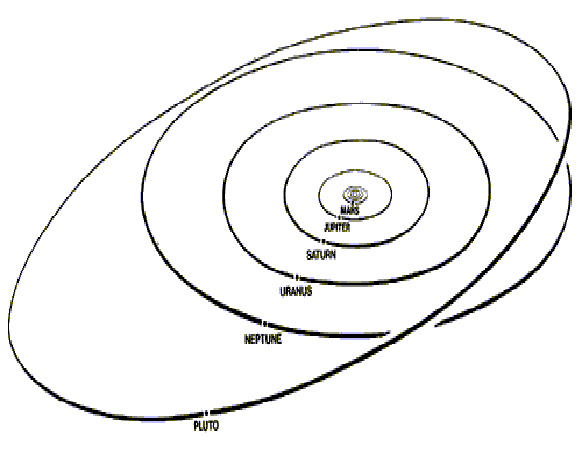MY MVG SPEECH
Did you know that Pluto was discovered by Clyde Tom Baugh in 1930 by a positive
mistake? His mistake had shown that there is a planet further than Neptune.
Scientists and astronomers carefully explored the discoveries of Pluto. Pluto
was too small of a planet, yet too big to be a star. After very careful sky
surveys, Pluto really did turn out to be a small planet.
Pluto's atmosphere is much thinner than Earth's, and it contains no oxygen,
so you can't breathe there. You would feel very light, since Pluto's gravitational
pull is 0,003 * Earth's gravity (9,8 N), therefore Pluto's gravity would be
around 0,0294 N . The ground around you might look like an ice-skating rink,
it looks very icy and hard, with a very low gravity
Pluto is the only planet that has not received any visitors. Only the Hubble
Space Telescope can see what is going on the surface on Pluto.
As you probably now know the name Pluto came from a Roman legend? According
to Roman legends, Pluto (Greek: Hades) is the god of the underworld. The planet
definitely received this name because it's so far from the Sun that it is in
unending darkness.
Did you know that at some times Pluto's orbit is at times not the furthest
from the sun? I.e. Between January 1979 and February 11 1999 Pluto's orbit was
closer to the Sun than Neptune's. Pluto rotates in the opposite direction from
most of the other planets. Here is a diagram showing Pluto's orbit.
Pluto is the smaller than seven of the moons in our solar system (the Moon (our
moon), Io, Europa, Ganymede, Callisto, Titan and Triton).
Like Earth, Pluto has only one moon. It's moon, Charon which is about half the
size of Pluto. Pluto and Charon are closer in size than any other planet-moon
system in our solar system, and are sometimes called a double planet. Pluto
has a very cold atmosphere, between about 35 and 45 Kelvin (-220 to -238 Celsius)(about
-380 F)
Pluto has a very long "day" it is about six earth days and 9 hours
Charon, Pluto's only satelite was discovered by Jim Christy during the late 70's (1978) which also was a mistake.
Here is a picture of Pluto's unusual orbit…...

The search for new planets did not really end with the discovery of Pluto, even though recent work suggests it's unlikely that another large planet orbits the Sun. However, some astronomers believe that numerous other planets/objects or celestials may hide on the outer bordering of the solar system. New discoveries show that there are millions of smaller icy, rocky objects orbiting in the Kuiper Belt, which is an enormous area that stretches past Neptune. Perhaps other worlds lie undiscovered in the darkness beyond Pluto and Charon.
Here is a picture of the Kiuper belt…..In some days, you will be able to read more about the Kuiper belt on my website

You can also read the complete information about Pluto…the address to
my website is:
www.science.knows.it